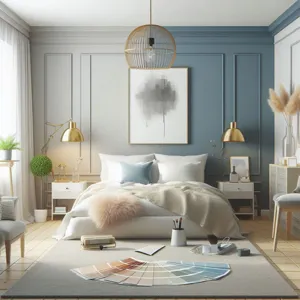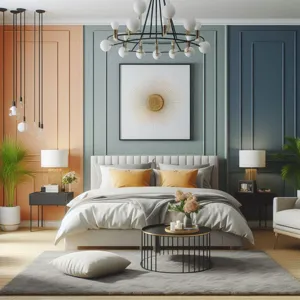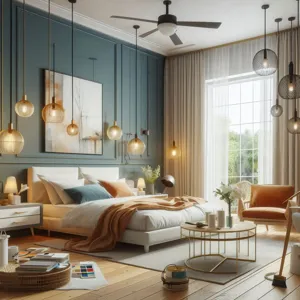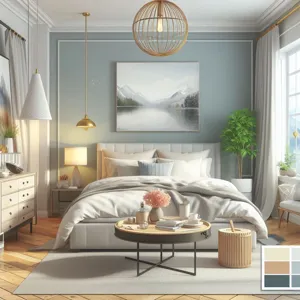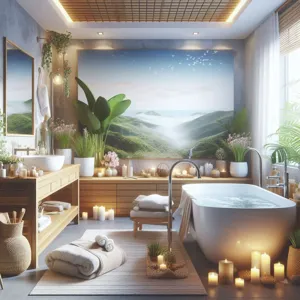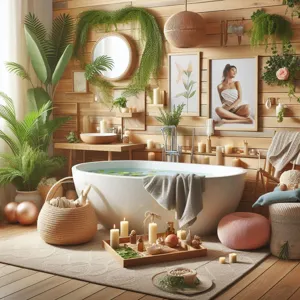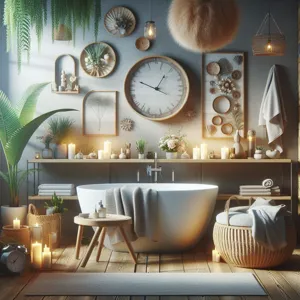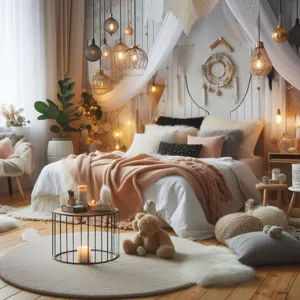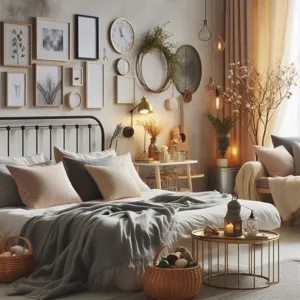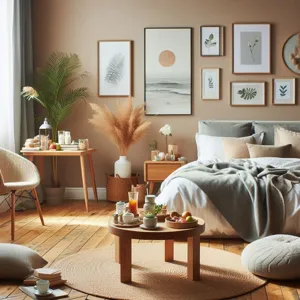Your bedroom should be more than just a place to sleep; it should be a sanctuary where you can escape the chaos of the outside world and rejuvenate your spirit.
In today’s fast-paced life, creating a serene and relaxing bedroom is essential for promoting restful sleep and overall well-being. Imagine stepping into a space that envelops you in tranquility—a retreat adorned with calming colors, soft textures, and personal touches that reflect your unique style. In this blog post, we’ll explore top tips for transforming your bedroom into a peaceful haven. From selecting the right color palette to optimizing lighting and incorporating soothing scents, we’ll guide you through every step to cultivate an atmosphere that encourages relaxation and rejuvenation. Say goodbye to stress and hello to serenity as you embark on this journey to create your perfect sleep sanctuary!
1. Understanding the Importance of a Serene Bedroom
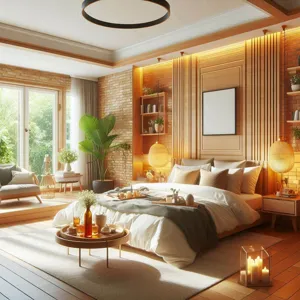
Creating a serene bedroom is more than just an aesthetic choice; it’s a vital component of your overall well-being. In our fast-paced lives, where stress often lurks around every corner, the bedroom serves as a personal sanctuary — a space to unwind, recharge, and escape the chaos of the outside world. Understanding the importance of this sacred space can profoundly impact your mental and physical health.
A serene bedroom fosters a sense of calm and tranquility, helping you to cultivate a restful environment that promotes quality sleep. Quality sleep is essential for a robust immune system, improved mood, and enhanced cognitive function. When your bedroom is designed for relaxation, it not only encourages you to slip into slumber more easily but also allows you to wake up feeling refreshed and rejuvenated.
Moreover, a harmonious bedroom can act as a daily retreat for meditation or reflection, allowing you to start and end your day with clarity. Imagine stepping into a space filled with soothing colors, gentle textures, and minimal distractions—each element carefully curated to evoke peace and serenity. By prioritizing a serene bedroom, you are investing in yourself; you are choosing to create a haven that nurtures your soul and enhances your everyday life.
In the following sections, we will explore practical tips and design ideas that can transform your bedroom into a serene oasis, perfectly tailored to your unique preferences and lifestyle. Get ready to embrace the tranquility that comes from understanding the profound importance of a calm and relaxing bedroom.
2. Choosing the Right Color Palette for Calmness
When it comes to transforming your bedroom into a serene sanctuary, the color palette you choose plays a pivotal role in setting the mood. Colors have the power to evoke emotions and influence our state of mind, making it essential to select hues that promote calmness and relaxation.
Start by considering soft, muted tones that create a soothing atmosphere. Shades of blue, for instance, are renowned for their tranquil qualities, reminiscent of clear skies and serene waters. Light blues, in particular, can help lower blood pressure and reduce stress levels, making them an excellent choice for a restful retreat.
Alternatively, consider gentle greens, which evoke the refreshing essence of nature. Soft sage or mint green can create an inviting and rejuvenating space, bringing a sense of peace and balance that encourages relaxation. For those who prefer warmth, soft beige or creamy whites can provide a cozy backdrop without overwhelming the senses. These neutral tones work beautifully with natural textures, enhancing the overall serenity of the room.
Avoid overly vibrant or harsh colors, as they can be stimulating and detract from the tranquil atmosphere you aim to achieve. If you desire a touch of boldness, consider incorporating deeper shades as accents through pillows, throws, or artwork, allowing for a burst of personality without compromising the overall calmness.
Remember, the key to a serene bedroom lies in the harmonious interplay of colors. Mixing and matching different shades within your chosen palette can add depth and dimension while maintaining a cohesive look. By thoughtfully selecting your color scheme, you can create a peaceful haven that invites relaxation and rejuvenation, turning your bedroom into the ultimate sanctuary.
3. Essential Furniture for a Relaxing Space
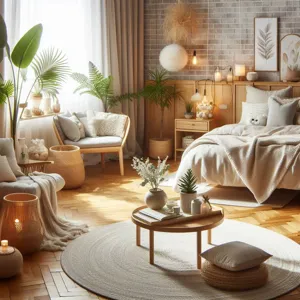
When it comes to crafting a serene and relaxing bedroom, the right furniture choices can make all the difference. Think of your bedroom as a sanctuary, a personal retreat where comfort reigns supreme. Here are some essential pieces to consider for creating that tranquil atmosphere.
**1. A Luxurious Bed:** The centerpiece of any bedroom is undoubtedly the bed. Opt for a high-quality mattress that suits your comfort needs, paired with soft, breathable bedding. Consider a plush headboard that not only adds style but also provides a cozy backrest for reading or relaxing. Layer your bed with a combination of pillows—varying in sizes and textures—to create an inviting, cloud-like escape.
**2. Cozy Seating:** Incorporate a comfortable chair or a small loveseat in a corner of the room. This cozy nook can serve as a perfect spot for morning coffee, reading, or simply unwinding with a good book. Choose fabrics that feel soft against your skin, like velvet or high-thread-count cotton, and consider seating that complements the overall aesthetic of your sanctuary.
**3. functional Nightstands:** On either side of your bed, functional nightstands are a must. They provide essential storage for nighttime essentials like books, glasses, and a glass of water. Choose nightstands that reflect your style—whether sleek and modern or rustic and charming—and consider pieces that offer drawers or shelves for added organization.
**4. Soft Lighting:** To create an atmosphere of calm, select lighting fixtures that provide a warm glow. Bedside lamps with dimmers allow you to adjust the brightness to suit your mood, while overhead fixtures should be soft and inviting. Consider using candles or string lights to add a touch of warmth and ambiance, perfect for those peaceful evenings.
**5. Minimalist Desks or Dressers:** If space allows, a minimalist desk can serve as a tranquil workspace, keeping clutter at bay while allowing you to focus on productivity without distraction. A well-organized dresser can also help maintain a serene environment, ensuring that everything has its place and your personal items remain tidy and out of view.
Incorporating these essential furniture pieces into your bedroom will not only enhance its functionality but will also foster a sense of tranquility. Remember, your sanctuary should reflect your personal style while promoting relaxation, allowing you to retreat from the chaos of daily life and recharge in a peaceful environment.
4. Decluttering: Creating a Minimalist Oasis
In the quest for a serene and relaxing bedroom, decluttering serves as a vital first step toward creating your minimalist oasis. A cluttered space often breeds a cluttered mind, making it difficult to unwind and find peace after a long day. To transform your bedroom into a sanctuary of calm, begin by assessing your belongings with a critical eye.
Start by removing everything from surfaces—dressers, nightstands, and even the floor. As you sort through items, ask yourself what truly deserves a place in your calming retreat. Keep only those items that bring you joy or serve a functional purpose. This could mean parting with extra pillows that never get used, decorative pieces that gather dust, or clothing that doesn’t fit your lifestyle.
Once you’ve sorted through your belongings, focus on creating designated spaces for the items you decide to keep. Invest in stylish storage solutions—think chic baskets or sleek boxes—that not only hide away clutter but also contribute to the overall aesthetic of your room. Remember, the goal is to minimize visual distractions, allowing your space to breathe and feel open.
Incorporating a minimalist approach doesn’t just clear physical space; it also sets the stage for a more mindful and intentional lifestyle. With fewer items vying for your attention, you create an environment that encourages relaxation and promotes restful sleep. Whether it’s a serene color palette, soft textures, or the gentle glow of ambient lighting, your decluttered sanctuary will become a retreat that nurtures both body and mind, inviting you to unwind and recharge.
5. Lighting Matters: How to Use Natural and Artificial Light

When it comes to creating a serene and relaxing bedroom, lighting plays a pivotal role in setting the mood and enhancing the overall ambiance. Both natural and artificial light can significantly influence how you feel in your space, so it’s essential to strike the right balance.
Start by harnessing the power of natural light. Consider the layout of your room and the position of your windows. During the day, let sunlight pour in by using sheer, light-filtering curtains that provide privacy without sacrificing brightness. Position your furniture to take advantage of the sun’s path; a cozy reading nook by the window can become your favorite retreat for basking in the warmth of daylight. If privacy is a concern, consider using reflective surfaces or strategically placed mirrors to amplify the natural light, creating an illusion of a larger, brighter space.
As twilight approaches, it’s time to layer in artificial lighting. A well-thought-out lighting scheme can transform your bedroom from a bustling daytime hub to a peaceful nighttime sanctuary. Start with ambient lighting—soft overhead fixtures or wall-mounted sconces that cast a warm glow help create a relaxing atmosphere. Supplement this with task lighting, like bedside lamps or adjustable reading lights, to ensure you have adequate light for nighttime activities without overwhelming brightness.
Don’t underestimate the power of dimmers! Installing dimmer switches allows you to control the intensity of your lights, letting you transition seamlessly from bright, energizing light in the morning to soft, calming light in the evening. For a touch of warmth, consider incorporating candles or string lights for an inviting, cozy feel.
Finally, remember that color temperature matters. Opt for warmer hues in your artificial lighting to promote relaxation and comfort, steering clear of harsh, cool tones that can be stimulating. By thoughtfully combining natural and artificial light, you can create a harmonious and inviting sanctuary that beckons you to unwind and recharge after a long day.
6. Incorporating Nature: Plants for Peace and Relaxation
Incorporating nature into your bedroom design is a powerful way to cultivate a serene and relaxing atmosphere. The presence of plants not only enhances the aesthetic appeal of your sanctuary but also contributes to your overall well-being. Studies have shown that being surrounded by greenery can reduce stress, improve air quality, and promote a sense of calm.
When selecting plants for your bedroom, consider the following options that thrive in lower light conditions and are known for their air-purifying qualities. Snake plants, for example, are virtually indestructible and can help filter out toxins while releasing oxygen at night, making them a perfect companion for restful sleep. Peace lilies are another excellent choice; their lush foliage and elegant white blooms can transform any corner into a tranquil retreat while absorbing harmful pollutants.
If you’re looking for a more fragrant option, consider incorporating lavender or jasmine. Not only do these plants bring a delightful aroma, but they are also renowned for their calming effects, which can help reduce anxiety and promote relaxation. For those who prefer a minimalist approach, small succulents or cacti can add a touch of nature without overwhelming your space.
To effectively integrate plants into your bedroom, think about placement. A large potted plant in a corner can create a focal point, while smaller plants on bedside tables or shelves can serve as delightful reminders of nature right where you need them. Hanging planters can also add dimension to your space, drawing the eye upwards and creating a sense of openness.
Remember, the goal is to create a calming environment, so choose pots and planters that complement your existing décor. Whether you opt for sleek ceramic vessels or rustic wooden boxes, the right containers can enhance the overall aesthetic of your sanctuary.
By bringing nature into your bedroom, you’re not just decorating—you’re creating a peaceful oasis that invites relaxation and rejuvenation. Take a moment to nurture your plants, and in return, they will help nurture your mind, body, and spirit, making your bedroom a true sanctuary of tranquility.
7. Textures and Fabrics That Promote Comfort
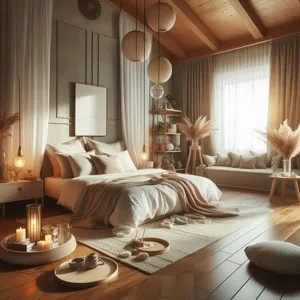
Creating a serene and relaxing bedroom goes beyond just color palettes and layouts; the textures and fabrics you choose play a pivotal role in establishing a calming atmosphere. Soft, inviting materials can transform your space into a sanctuary where you can unwind and recharge.
Start with your bedding—invest in high-quality sheets made from natural fibers like cotton, linen, or bamboo. These materials not only feel luxurious against your skin but also promote breathability, ensuring a comfortable night’s sleep. Opt for a duvet or comforter with a plush texture that adds an inviting layer of warmth, making your bed a cozy retreat.
Don’t overlook throw pillows and blankets. Incorporating a variety of textures, such as velvet, knitted, or faux fur, can enhance the visual appeal of your bedroom while providing tactile comfort. Layering different fabrics invites relaxation, as you can snuggle up with a soft throw while reading or watching your favorite show.
Rugs can also contribute significantly to the overall comfort of your space. A thick, shaggy rug can create a warm, cushioned surface underfoot, making your bedroom feel more inviting. Choose a color that complements your decor but also invokes a sense of calm—think soft neutrals or muted pastels.
Finally, consider the curtains or window treatments you use. Heavy drapes can block out light and insulate against noise, while sheer fabrics allow for gentle light filtration, creating a soothing ambiance. The right fabric can help you control the mood of the room, whether you want a bright, airy feel during the day or a dark, peaceful environment at night.
By thoughtfully selecting textures and fabrics that promote comfort, you can create a bedroom that not only looks beautiful but also feels like a true sanctuary, encouraging relaxation and tranquility at the end of a long day.
8. The Role of Aromatherapy in a Relaxing Bedroom
Aromatherapy plays a pivotal role in transforming your bedroom into a serene sanctuary. The power of scent is profound; it can evoke memories, influence moods, and even promote relaxation. Incorporating essential oils into your space not only enhances the ambiance but also provides therapeutic benefits that can help you unwind after a long day.
To begin, consider investing in a high-quality diffuser. This device disperses essential oils into the air, filling your bedroom with soothing aromas that can create a tranquil atmosphere. Popular choices for relaxation include lavender, known for its calming properties, and chamomile, which can help ease anxiety and promote sleep. A few drops of eucalyptus or sandalwood can also cleanse the air and bring a sense of peace to your environment.
For those who prefer a more hands-on approach, you might explore using scented candles or pillow sprays infused with essential oils. Lighting a candle as part of your evening ritual can signal to your mind that it’s time to relax and prepare for rest. Similarly, a gentle spritz of lavender pillow spray can lull you into a state of calm, making it easier to drift off to sleep.
Remember, the key to effective aromatherapy is personalization. Experiment with different scents to find what resonates most with you. You might even create your own blends, combining oils that appeal to your senses and reflect your unique style. By introducing the right aromas into your bedroom, you can cultivate an inviting space that nurtures relaxation, rejuvenation, and a deeper connection to your inner peace.
9. Creating a Relaxation Zone: Reading Nooks and More
Creating a relaxation zone within your bedroom can transform it from a simple sleeping space into a personal sanctuary where you can unwind and recharge. One of the best ways to do this is by incorporating a cozy reading nook. Imagine curling up in a plush armchair or a hammock chair, surrounded by soft pillows and a warm throw blanket, with your favorite book in hand. Position this nook near a window to take advantage of natural light during the day, or add a stylish floor lamp for those tranquil evenings when you want to lose yourself in the pages of a gripping novel.
To enhance the atmosphere, consider adding soothing elements that engage your senses. A small side table can hold a steaming cup of herbal tea or a fragrant candle to create an inviting ambiance. Incorporate soft textures through a shaggy rug or layered cushions to provide comfort and warmth. You might also want to include a small bookshelf or a decorative basket filled with your top reads, allowing for easy access while adding a personal touch to your space.
Beyond reading nooks, think about other relaxation zones you can create. A meditation corner with floor cushions and calming art can offer a peaceful retreat for mindfulness practices. You could also include a small indoor plant or a water feature, like a tabletop fountain, to introduce a sense of tranquility and connection to nature.
By thoughtfully designing these relaxation zones, you can cultivate an environment that encourages unwinding after a long day, fostering a sense of peace and serenity that will make your bedroom a cherished retreat.
10. Tips for Soundproofing Your Bedroom
Creating a serene and relaxing bedroom often starts with ensuring that your space is a sanctuary of peace. One of the most crucial elements in achieving that tranquility is soundproofing. Noise from outside—whether it’s bustling city sounds, neighbors, or even the hum of traffic—can disrupt your sleep and overall relaxation. Here are some effective tips for soundproofing your bedroom, helping you create the perfect retreat.
**1. Choose the Right Windows:** Start with your windows, as they often serve as the primary entry point for external noise. Consider upgrading to double-glazed windows, which are designed to provide better insulation against sound. If replacement isn’t an option, adding thick curtains or soundproof window inserts can significantly reduce noise levels.
**2. Invest in Quality Doors:** Solid-core doors are your best bet for soundproofing. Unlike hollow doors, which allow sound to travel easily, solid-core doors absorb sound and create a more peaceful environment. Additionally, ensure that your door fits snugly in its frame; adding a door sweep can seal gaps at the bottom where sound can sneak in.
**3. Utilize Soft Furnishings:** Soft textiles can absorb sound effectively. Consider incorporating plush rugs, upholstered furniture, and heavy drapes into your décor. The more fabric you add to the space, the less echo and noise will bounce around your room.
**4. Add Acoustic Panels:** For a more professional approach, acoustic panels can be installed on walls to absorb sound. These panels come in various designs and colors, allowing you to enhance your bedroom’s aesthetic while quietly muting disruptive noises from outside.
**5. Create a Layered Sound Barrier:** If noise continues to be a problem, you might consider creating a layered sound barrier. Placing bookshelves filled with books or decorative items against the wall shared with noisy neighbors can help muffle sound. This not only serves a practical purpose but also enhances your room’s visual appeal.
**6. White Noise Machines:** For those particularly sensitive to sound, white noise machines can be a game changer. These devices produce a consistent sound that masks disruptive noises, creating a soothing auditory backdrop that can lull you to sleep.
By implementing these soundproofing strategies, you can transform your bedroom into a tranquil oasis, free from the disturbances of the outside world. A little effort in soundproofing goes a long way in ensuring that your bedroom remains a serene space for rest, relaxation, and rejuvenation.
11. Personalizing Your Space with Meaningful Decor
Personalizing your space with meaningful decor can transform your bedroom from a simple resting place into a sanctuary that resonates with your identity and experiences. The items you choose to display should tell your story, evoke positive emotions, and create an atmosphere that soothes your mind and spirit.
Start by selecting pieces that hold special significance to you. Perhaps it’s a framed photograph from a cherished vacation or a piece of art created by a loved one. Incorporating these items not only adds a personal touch but also infuses your space with warmth and nostalgia. Consider a gallery wall where you can showcase a collection of memories, achievements, and inspirations. This visual narrative serves as a daily reminder of what you value most.
Textures also play a vital role in personalization. Layering different fabrics—such as a soft throw blanket, plush pillows, or a textured area rug—can make your bedroom feel more inviting. Choose colors and patterns that resonate with your style and evoke a sense of calm. Soft, muted tones can create a tranquil atmosphere, while bolder hues can energize the space.
Incorporating elements from nature, such as indoor plants or natural wood accents, can enhance the serene quality of your bedroom. Plants not only purify the air but also bring life and vibrancy into your personal oasis.
Finally, consider adding items that promote relaxation and mindfulness. A small bookshelf filled with your favorite novels, a cozy reading nook, or soothing candles can all contribute to a peaceful environment where you can unwind at the end of the day.
By curating a space filled with meaningful decor that reflects your personality and aspirations, you cultivate an environment that nurtures relaxation and rejuvenation. Your bedroom becomes more than just a place to sleep; it evolves into a haven that inspires serenity and well-being.
12. Technology Detox: Creating a Screen-Free Sanctuary
In our fast-paced, tech-driven world, our bedrooms often become an extension of our devices, flooded with notifications, blue light, and the constant buzz of connectivity. To truly transform your sanctuary into a serene retreat, consider implementing a technology detox—an intentional step towards creating a screen-free haven that promotes relaxation and rejuvenation.
Start by designating your bedroom as a tech-free zone. This means removing televisions, computers, and even smartphones from the space. Instead, cultivate an environment that encourages mindfulness and tranquility. You can replace the digital clutter with calming elements such as books, soft lighting, and soothing scents. A stack of your favorite novels on the bedside table invites quiet evenings of escape through reading, while a scented candle or essential oil diffuser can enhance the ambiance with calming aromas like lavender or chamomile.
To further embrace the serenity of a screen-free sanctuary, consider incorporating natural elements into your bedroom. Houseplants not only purify the air but also connect you to nature, fostering a sense of peace. Opt for low-maintenance varieties like snake plants or peace lilies, which thrive in various lighting conditions.
Moreover, establish a nightly routine that signals the end of the day and promotes relaxation. This could include activities like journaling, meditating, or practicing gentle yoga. By replacing screen time with these calming rituals, you’ll create a peaceful atmosphere that encourages restful sleep and rejuvenation.
Lastly, consider how you can enhance your bedroom’s design to reflect this tech-free philosophy. Opt for cozy textiles, such as soft throws and plush cushions, to create a warm and inviting space. Choose colors that evoke calmness—soft blues, greens, or earthy tones can help create a serene backdrop that encourages relaxation.
By committing to a technology detox in your bedroom, you’re not just cutting down on screen time; you’re actively crafting a sanctuary that nurtures your well-being. Embrace the peace and tranquility that comes with disconnecting, and watch as your bedroom transforms into the ultimate retreat for rest and rejuvenation.
13. Establishing a Nighttime Routine for Better Sleep
Establishing a nighttime routine is one of the most effective strategies for enhancing your sleep quality and creating a tranquil bedroom environment. In today’s fast-paced world, it’s easy to fall into a pattern of late-night screen time, stress, and disorganization, all of which can disrupt your ability to unwind and rest fully. By implementing a consistent pre-sleep routine, you signal to your body that it’s time to relax and prepare for restorative sleep.
Start by setting a specific bedtime that allows for at least seven to eight hours of quality sleep. Once you have your target bedtime, work backward to determine when you should start winding down. Consider including calming activities in your routine, such as dimming the lights, switching off electronic devices, and engaging in relaxing practices like reading a book, sipping herbal tea, or practicing gentle yoga stretches. These activities not only help to lower stress levels but also create a peaceful atmosphere that encourages your mind and body to transition into sleep mode.
Incorporating mindfulness techniques, such as meditation or deep breathing exercises, can further enhance your nighttime routine. Spending even just a few minutes focusing on your breath can help clear your mind of the day’s worries and promote a sense of calm. Additionally, consider creating a soothing ambiance in your bedroom—experiment with essential oils, soft lighting, or even a white noise machine to create an environment that feels safe and nurturing.
Remember, consistency is key. By sticking to your nighttime routine, you reinforce healthy sleep habits, making it easier for your body to recognize when it’s time to relax and rejuvenate. Over time, these simple yet powerful practices will transform your bedroom into a serene sanctuary, ultimately leading to better sleep and a more restful night. Embrace the tranquility of a well-established routine, and watch as your bedroom evolves into the peaceful haven you’ve always desired.
14. The Importance of Organization and Storage Solutions
When it comes to creating a serene and relaxing bedroom, organization and effective storage solutions are paramount. A cluttered space can lead to a cluttered mind, making it difficult to unwind and recharge. By implementing thoughtful organization techniques, you can transform your bedroom into a tranquil retreat that promotes peace and relaxation.
Start by assessing your space and identifying areas that need improvement. Invest in multifunctional furniture, such as a bed with built-in drawers or a storage ottoman, which can help you maximize storage while maintaining a sleek appearance. These pieces not only provide practical solutions for stowing away extra blankets or books but also keep your bedroom looking neat and tidy.
Consider utilizing vertical space to your advantage. Wall-mounted shelves or floating nightstands can free up floor space, giving the illusion of a larger room while providing convenient storage for books, decorative items, or personal treasures. Additionally, using decorative baskets or bins can add style to your organization efforts, allowing you to store items like clothes or accessories out of sight while still being easily accessible.
Don’t forget about your closet! A well-organized closet can make a significant difference in your daily routine and overall bedroom atmosphere. Use matching hangers, drawer dividers, and clear storage boxes to create a cohesive and visually appealing system for your clothes and accessories. Seasonal rotations can also help keep your wardrobe manageable and your closet space optimized.
Finally, remember to regularly declutter your bedroom. Set aside time each month to evaluate what you truly need and cherish. Letting go of items that no longer serve you can bring a refreshing sense of clarity to your space, fostering a serene environment where you can truly relax and unwind. By prioritizing organization and thoughtful storage solutions, you’ll cultivate a peaceful sanctuary that invites tranquility into your life.
15. Regular Maintenance: Keeping Your Sanctuary Serene
Regular maintenance is the unsung hero of a serene bedroom sanctuary. While it may be tempting to think that once you’ve created your tranquil oasis, the work is done, the truth is that a little ongoing care can make a substantial difference in maintaining the calm atmosphere you’ve cultivated.
Start with the basics: dusting surfaces, vacuuming, and washing your bedding regularly. Fresh, clean linens not only enhance comfort but also contribute to a peaceful aesthetic. Aim to change your sheets at least once a week; the sensation of slipping into a bed made with crisp, freshly laundered sheets is one of life’s simplest pleasures.
Next, pay attention to the decor. Over time, knick-knacks can accumulate, and clutter can creep in, disrupting the serene vibe. Make it a habit to declutter your space regularly, perhaps once a month, to evaluate what items truly contribute to your sanctuary and what can be removed. This process not only keeps your bedroom looking tidy but also creates a more calming environment.
Don’t forget about the air quality in your sanctuary. Consider investing in air purifiers or incorporating houseplants that improve air quality, like peace lilies or snake plants. Regularly checking the filters in your HVAC system and keeping windows open when possible can also help ensure that the air you breathe is fresh and revitalizing.
Lastly, check the ambiance of your space. Dimmer switches, soft lighting, and calming scents from essential oil diffusers or candles can dramatically enhance the atmosphere. Make it a point to refresh any scent diffusers or replace burnt-out light bulbs to keep the mood just right.
By incorporating these simple maintenance tips into your routine, you’ll ensure that your bedroom remains the serene retreat you envisioned, a sanctuary where you can escape the hustle and bustle of daily life and truly unwind.
In conclusion, transforming your bedroom into a serene sanctuary is an achievable goal that can significantly enhance your well-being and overall quality of life. By incorporating the thoughtful tips outlined in this post—from selecting calming color palettes and investing in quality bedding to minimizing clutter and embracing soft lighting—you can create a personal retreat that promotes relaxation and rejuvenation. Remember that the journey to a serene space is personal, so take the time to infuse your unique style and preferences into your sanctuary. As you embark on this transformation, may your bedroom become a haven of peace and comfort, inviting you to unwind and recharge after a long day. Sweet dreams and restful nights await you!

